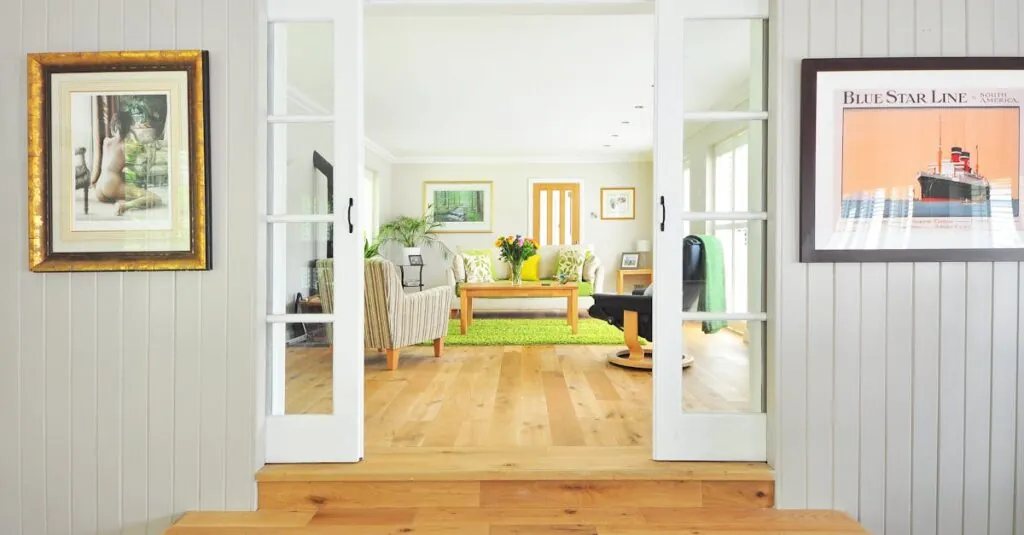Imagine stepping into a living room that feels like a breath of fresh air. Minimalist decor isn’t just a trend; it’s a lifestyle choice that transforms cluttered chaos into serene simplicity. With its clean lines and understated elegance, minimalist design invites calmness into everyday life, making it the perfect antidote to modern madness.
Table of Contents
ToggleUnderstanding Minimalist Decor
Minimalist decor focuses on simplicity and tranquility in living spaces. This design style effectively reduces clutter and creates calming environments.
Origins of Minimalism
Minimalism traces its roots to the mid-20th century. Influenced by art movements like minimalism, architects and designers embraced a philosophy emphasizing simplicity. Early adopters sought to strip away excess, prioritizing function over form. As a lifestyle choice, minimalism gained traction during the 1990s, promoting the idea that less truly is more. Japanese aesthetics, particularly the concept of wabi-sabi, further shaped minimalist principles, blending beauty and simplicity.
Key Principles of Minimalist Design
Key principles drive the essence of minimalist design. Clean lines create visual harmony, eliminating distractions. Neutral color palettes foster a sense of peace, with whites, grays, and beiges frequently used. Natural materials, such as wood and stone, enhance the organic feel of spaces. Decluttered surfaces promote focus, while multifunctional furniture optimizes space utilization. Each element holds significance, supporting an overall simplified aesthetic. By adhering to these principles, minimalist decor elevates the living experience, ensuring serenity prevails.
Essential Elements of a Minimalist Decor Living Room
Creating a minimalist decor living room involves focusing on key elements that enhance simplicity and functionality. Attention to detail ensures that each piece contributes to the overall aesthetic without overwhelming the space.
Color Palette
Neutral color palettes dominate minimalist decor. Soft grays, whites, and beiges create a serene environment. Warm tones like taupe or muted greens can also enhance warmth without distraction. Cohesion among colors promotes a seamless flow throughout the space. Accent colors should appear sparingly, allowing an occasional pop of color to draw subtle attention. Each choice reflects serenity and intentionality, reinforcing the minimalist philosophy.
Furniture Selection
Selecting multifunctional furniture is essential in a minimalist living room. Pieces that serve dual purposes, like storage ottomans or extendable coffee tables, maximize functionality. Minimalist designs prioritize clean lines and unobtrusive forms. Avoiding heavy, bulky items keeps the space open and airy. A few carefully chosen furniture pieces can establish a focal point without cluttering the environment. Materials should reflect durability along with aesthetics, ensuring longevity and style.
Lighting Choices
Effective lighting enhances the minimalism of any room. Natural light plays a vital role, so sheer curtains can maximize brightness while maintaining privacy. Incorporating a few statement fixtures provides both function and artful expression. LED options promote energy efficiency while supporting minimalist values. Dimmable lights create ambiance, allowing flexibility throughout the day. Every lighting choice should harmonize with the overall decor philosophy, ensuring a bright yet calming atmosphere.
Creating a Minimalist Atmosphere
Creating a minimalist atmosphere involves intentional choices that enhance simplicity and serenity in the living room. Focus on decluttering and selecting the right textures and materials for an enhanced aesthetic.
Decluttering Strategies
Implement effective decluttering strategies to achieve a clean and open space. Begin by assessing items and eliminating those that no longer serve a purpose. Categorize belongings into keep, donate, or discard piles. Utilize storage solutions like baskets and discreet cabinets to hide away everyday items. Limit decor to a few selected pieces that add meaning or joy and avoid overwhelming the surfaces. Regularly review the space, maintaining a habit of minimalism that supports the overall atmosphere.
Textures and Materials
Incorporate a mix of textures and materials to create visual interest while maintaining a minimalist aesthetic. Select natural elements such as wood, stone, and metal for a harmonious design experience. Use soft textiles like linen or cotton for upholstery and throw pillows to add comfort without clutter. Neutral-colored rugs can define spaces while keeping the overall look seamless. Ensure materials complement each other, contributing to a cohesive and tranquil environment that invites relaxation.
Tips for Implementing Minimalist Decor
Creating a minimalist decor living room involves intentional choices that enhance simplicity and functionality. Below are tips to achieve the desired ambiance without overwhelming space.
Budget-Friendly Ideas
Selecting budget-friendly options can simplify the process. Consider secondhand furniture from thrift stores or online marketplaces. A fresh coat of paint on walls instantly transforms the room, while neutral tones establish a calming environment. DIY projects can help create customized decor, such as wall art or planters. Repurposing small items often brings unique character to spaces. Finally, focusing on quality over quantity ensures lasting value and enjoyment.
Making a Statement with Minimal Pieces
Focusing on statement pieces can elevate a minimalist living room. Choose one or two standout items like a large artwork or a bold coffee table. Large-scale designs can draw the eye and add interest to a subdued palette. Instead of cluttering surfaces, keep accessories to a minimum. Each chosen piece should evoke personal meaning or compliment the room’s design. Emphasizing craftsmanship and originality fosters a distinctive atmosphere aligned with minimalist principles.
Embracing minimalist decor in the living room can lead to a transformative experience. By prioritizing simplicity and functionality, individuals can create a serene space that promotes relaxation and focus. The thoughtful selection of neutral colors, multifunctional furniture, and intentional decor pieces fosters an inviting atmosphere.
Incorporating natural materials and textures adds depth while maintaining a cohesive look. With practical decluttering strategies and budget-friendly tips, anyone can achieve a minimalist aesthetic that reflects their personal style. Ultimately, minimalist decor isn’t just about aesthetics; it’s a lifestyle choice that encourages mindfulness and intentional living.









